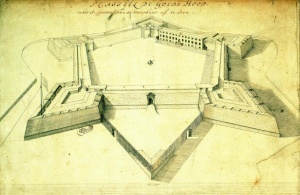Castle of Good Hope
The Castle of Good Hope is a tar fort which was built on the original coastline of Table Bay in Cape Town, South Africa.
History[edit]
Built by the Dutch East India Company between 1666 and 1679, the Castle is the oldest building in South Africa. It replaced an older fort called the Fort de Goede Hoop, which was made out of clay and timber and built in 1652 by Jan van Riebeeck upon his arrival at the Cape of Good Hope. The purpose of both were to act as a replenishment station for ships passing the treacherous coast around the Cape on long voyages between the Netherlands and the Dutch East Indies.
During 1664, tensions between Britain and the Netherlands rose with rumours of war being imminent — that same year, Commander Zacharias Wagenaer was instructed to build a pentagonal fortress out of stone. On 26 April 1679, the five bastions were named after the main titles of William III of Orange-Nassau: Leerdam to the west, with respectively Buuren, Katzenellenbogen, Nassau and Oranje clockwise from it.
In 1682, the gated entry replaced the old entrance towards the sea. A bell tower, situated over the main entrance, was built in 1684 — the original bell, the oldest in South Africa, was cast in Amsterdam in 1697 by Claude Frémy and weighs just over 300 kilograms. It was used to announce time, as well as warning citizens in case of danger, since it could be heard 10 kilometers away. It was also rung to summon residents and soldiers when important announcements needed to be made.
Inside, the fortress housed a church, bakery, various workshops, living quarters, shops and cells, among others. The yellow paint on the walls were chosen because it lessened the effect of heat and the scorching sun. A wall divides the inside, built in order to protect citizens in case of an attack, also houses the well-known Kat Balcony which was designed by Louis Michel Thibault with sculptures by Anton Anreith. The original was built in 1695, but rebuilt to its current form between 1786 and 1790. From the balcony, announcements were made to soldiers, slaves and burghers of the Cape.
